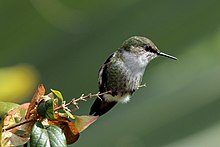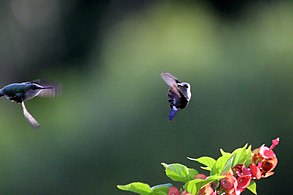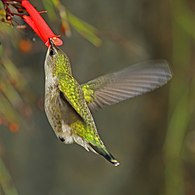Vervain hummingbird
| Vervain hummingbird | |
|---|---|

| |
| In Jamaica | |
| Scientific classification | |
| Kingdom: | Animalia |
| Phylum: | Chordata |
| Class: | Aves |
| Order: | Apodiformes |
| Family: | Trochilidae |
| Genus: | Mellisuga |
| Species: | M. minima
|
| Binomial name | |
| Mellisuga minima | |

| |
| Synonyms | |
|
Trochilus minimus Linnaeus, 1758 | |
The vervain hummingbird (Mellisuga minima) is a species of hummingbird found on Hispaniola (split between the Dominican Republic and Haiti) and Jamaica. Its natural habitats are tropical and subtropical moist broadleaf forests and heavily degraded former forests.
Taxonomy[]
The vervain hummingbird was formally described by the Swedish naturalist Carl Linnaeus in 1758 in the tenth edition of his Systema Naturae under the binomial name Trochilus minimus.[2] Linnaeus based his description on a bird that had been described and illustrated in 1747 by the English naturalist George Edwards.[3] The type locality is Jamaica.[4] The vervain hummingbird is now placed together with the tiny Cuban bee hummingbird in the genus Mellisuga that was introduced by the French zoologist Mathurin Jacques Brisson in 1760.[5][6]
Two subspecies are recognised:[6]
- M. m. minima (Linnaeus, 1758) – Jamaica
- M. m. vielloti (Shaw, 1812) – Hispaniola and nearby islands
Description[]
It is considered the second-smallest bird in the world after the bee hummingbird. Typical length is 6 cm (2.4 in), including the bill, and weight is 2–2.4 g (0.071–0.085 oz).[7] It also has among the smallest eggs of all birds, with an average length of 1 cm (0.39 in) and weight of 0.375 g.
Gallery[]

Courting, Jamaica

On nest

Feeding, Jamaica
References[]
- ^ BirdLife International (2016). "Mellisuga minima". IUCN Red List of Threatened Species. 2016: e.T22688229A93187970. doi:10.2305/IUCN.UK.2016-3.RLTS.T22688229A93187970.en. Retrieved 14 November 2021.
- ^ Linnaeus, Carl (1758). Systema Naturae per regna tria naturae, secundum classes, ordines, genera, species, cum characteribus, differentiis, synonymis, locis (in Latin). Volume 1 (10th ed.). Holmiae (Stockholm): Laurentii Salvii. p. 121.
|volume=has extra text (help) - ^ Edwards, George (1747). A Natural History of Uncommon Birds. Part 2. London: Printed for the author at the College of Physicians. p. 105.
- ^ Peters, James Lee, ed. (1945). Check-List of Birds of the World. Volume 5. Cambridge, Massachusetts: Harvard University Press. p. 136.
|volume=has extra text (help) - ^ Brisson, Mathurin Jacques (1760). Ornithologie, ou, Méthode contenant la division des oiseaux en ordres, sections, genres, especes & leurs variétés (in French and Latin). Volume 1. Paris: Jean-Baptiste Bauche. Vol. 1, p. 40, Vol. 3, p. 694.
|volume=has extra text (help) - ^ a b Gill, Frank; Donsker, David; Rasmussen, Pamela, eds. (January 2021). "Hummingbirds". IOC World Bird List Version 11.1. International Ornithologists' Union. Retrieved 7 February 2021.
- ^ Steven Latta; Christopher Rimmer; Allan Keith; James Wiley; Herbert Raffaele; Kent McFarland; Eladio Fernandez (15 May 2010). Birds of the Dominican Republic and Haiti. Princeton University Press. pp. 135–. ISBN 978-0-691-11891-8. Retrieved 23 August 2012.
Further reading[]
- Raffaele, Herbert; James Wiley, Orlando Garrido, Allan Keith & Janis Raffaele (2003) Birds of the West Indies, Christopher Helm, London.
- IUCN Red List least concern species
- Mellisuga
- Endemic birds of the Caribbean
- Birds of the Dominican Republic
- Birds of Haiti
- Birds of Jamaica
- Birds described in 1758
- Taxa named by Carl Linnaeus
- Hummingbird stubs



